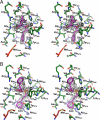Structural basis for the inhibition of the essential Plasmodium falciparum M1 neutral aminopeptidase
- PMID: 19196988
- PMCID: PMC2636733
- DOI: 10.1073/pnas.0807398106
Structural basis for the inhibition of the essential Plasmodium falciparum M1 neutral aminopeptidase
Abstract
Plasmodium falciparum parasites are responsible for the major global disease malaria, which results in >2 million deaths each year. With the rise of drug-resistant malarial parasites, novel drug targets and lead compounds are urgently required for the development of new therapeutic strategies. Here, we address this important problem by targeting the malarial neutral aminopeptidases that are involved in the terminal stages of hemoglobin digestion and essential for the provision of amino acids used for parasite growth and development within the erythrocyte. We characterize the structure and substrate specificity of one such aminopeptidase, PfA-M1, a validated drug target. The X-ray crystal structure of PfA-M1 alone and in complex with the generic inhibitor, bestatin, and a phosphinate dipeptide analogue with potent in vitro and in vivo antimalarial activity, hPheP[CH(2)]Phe, reveals features within the protease active site that are critical to its function as an aminopeptidase and can be exploited for drug development. These results set the groundwork for the development of antimalarial therapeutics that target the neutral aminopeptidases of the parasite.
Conflict of interest statement
The authors declare no conflict of interest.
Figures




Comment in
-
On the location of the aminopeptidase N homolog PfA-M1 in Plasmodium falciparum.Proc Natl Acad Sci U S A. 2009 Jun 2;106(22):E55; author reply E56. doi: 10.1073/pnas.0903493106. Epub 2009 May 22. Proc Natl Acad Sci U S A. 2009. PMID: 19470451 Free PMC article. No abstract available.
References
-
- Rosenthal PJ. Antimalarial drug discovery: Old and new approaches. J Exp Biol. 2003;206:3735–3744. - PubMed
-
- Lew VL, Macdonald L, Ginsburg H, Krugliak M, Tiffert T. Excess hemoglobin digestion by malaria parasites: A strategy to prevent premature host cell lysis. Blood Cells Mol Dis. 2004;32:353–359. - PubMed
-
- Klemba M, Gluzman I, Goldberg DE. A Plasmodium falciparum dipeptidyl aminopeptidase I participates in vacuolar hemoglobin degradation. J Biol Chem. 2004;279:43000–43007. - PubMed
Publication types
MeSH terms
Substances
Associated data
- Actions
- Actions
- Actions
LinkOut - more resources
Full Text Sources
Other Literature Sources

